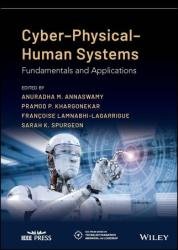 Название: Cyber-Physical-Human Systems: Fundamentals and Applications
Название: Cyber-Physical-Human Systems: Fundamentals and ApplicationsАвтор: Anuradha M. Annaswamy, Pramod P. Khargonekar, Francoise Lamnabhi-Lagarrigue
Издательство: Wiley-IEEE Press
Год: 2023
Страниц: 595
Язык: английский
Формат: pdf (true)
Размер: 19.8 MB
Cyber–Physical–Human Systems A comprehensive edited volume exploring the latest in the interactions between cyber–physical systems and humans In Cyber–Physical–Human Fundamentals and Applications , a team of distinguished researchers delivers a robust and up-to-date volume of contributions from leading researchers on Cyber–Physical–Human Systems, an emerging class of systems with increased interactions between cyber–physical, and human systems communicating with each other at various levels across space and time, so as to achieve desired performance related to human welfare, efficiency, and sustainability. The editors have focused on papers that address the power of emerging CPHS disciplines, all of which feature humans as an active component during cyber and physical interactions. Articles that span fundamental concepts and methods to various applications in engineering sectors of transportation, robotics, and healthcare and general socio-technical systems such as smart cities are featured. Together, these articles address challenges and opportunities that arise due to the emerging interactions between cyber–physical systems and humans, allowing readers to appreciate the intersection of cyber–physical system research and human behavior in large-scale systems. In the book, readers will also Perfect for cyber–physical systems researchers, academics, and graduate students, Cyber–Physical–Human Fundamentals and Applications will also earn a place in the libraries of research and development professionals working in industry and government agencies.
Traditional industrial robots are usually separated from humans by placing them in specially designed work cells or restricting their coexistence with barriers or cages, partly for human safety and partly because it is assumed that robot capabilities and human abilities are largely mutually exclusive. This perspective has shifted substantially in recent years, with the shared theme that the skills of people and robots are mainly complementary if they properly used. Recent advances in robotics (e.g. Kinova, Kuka iiwa) have made it possible for humans to securely share the workspace of robots. Human–robot cooperation (HRC), in which robots and human coworkers share the workspace and collaborate same activities, has sparked a lot of attention. In the current HRC, the strengths of robotic systems (e.g. accuracy, power) and human collaborators (e.g. sensing, decision-making) may be combined to overcome the robots’ and humans’ inherent limitations.
Скачать Cyber-Physical-Human Systems: Fundamentals and Applications